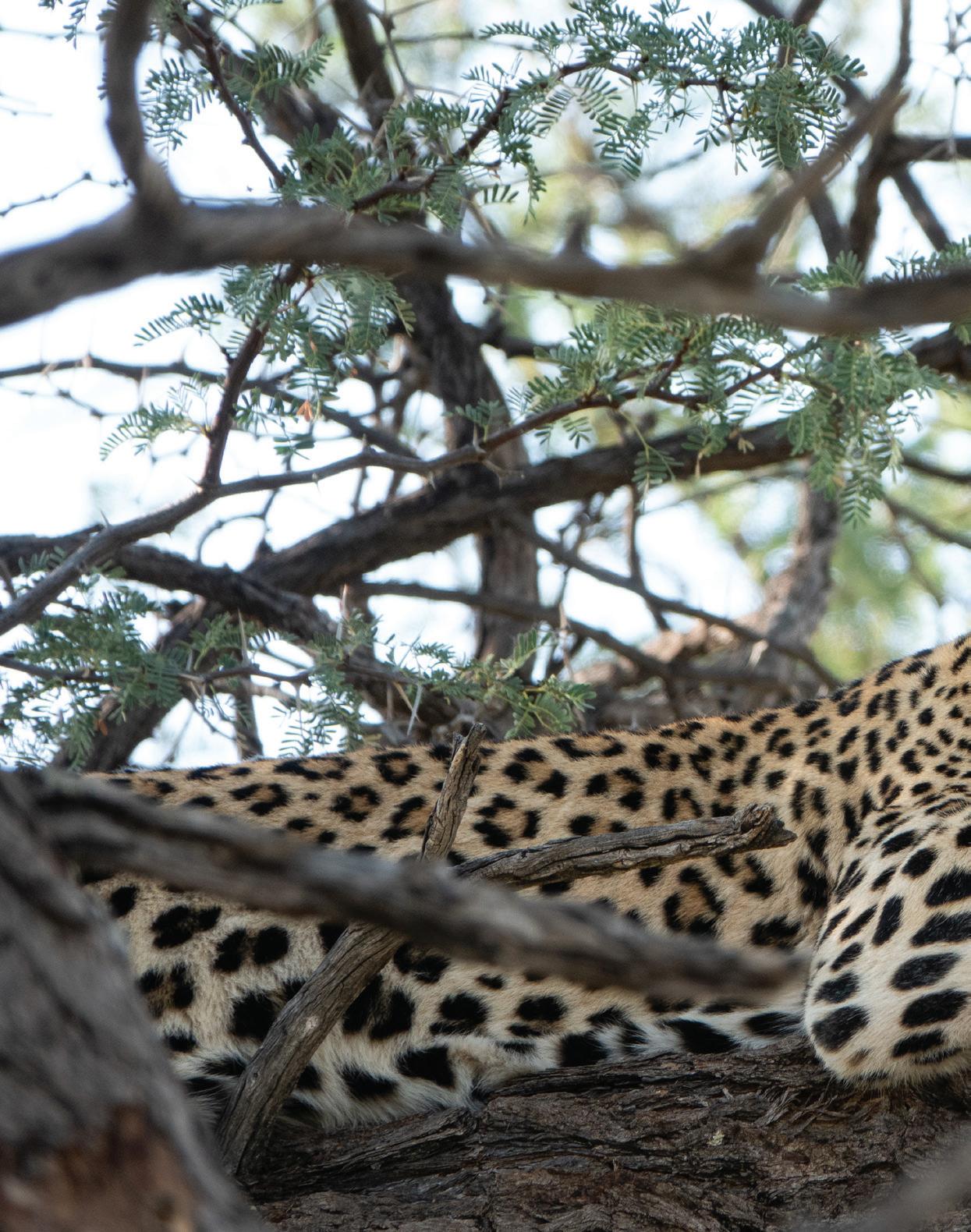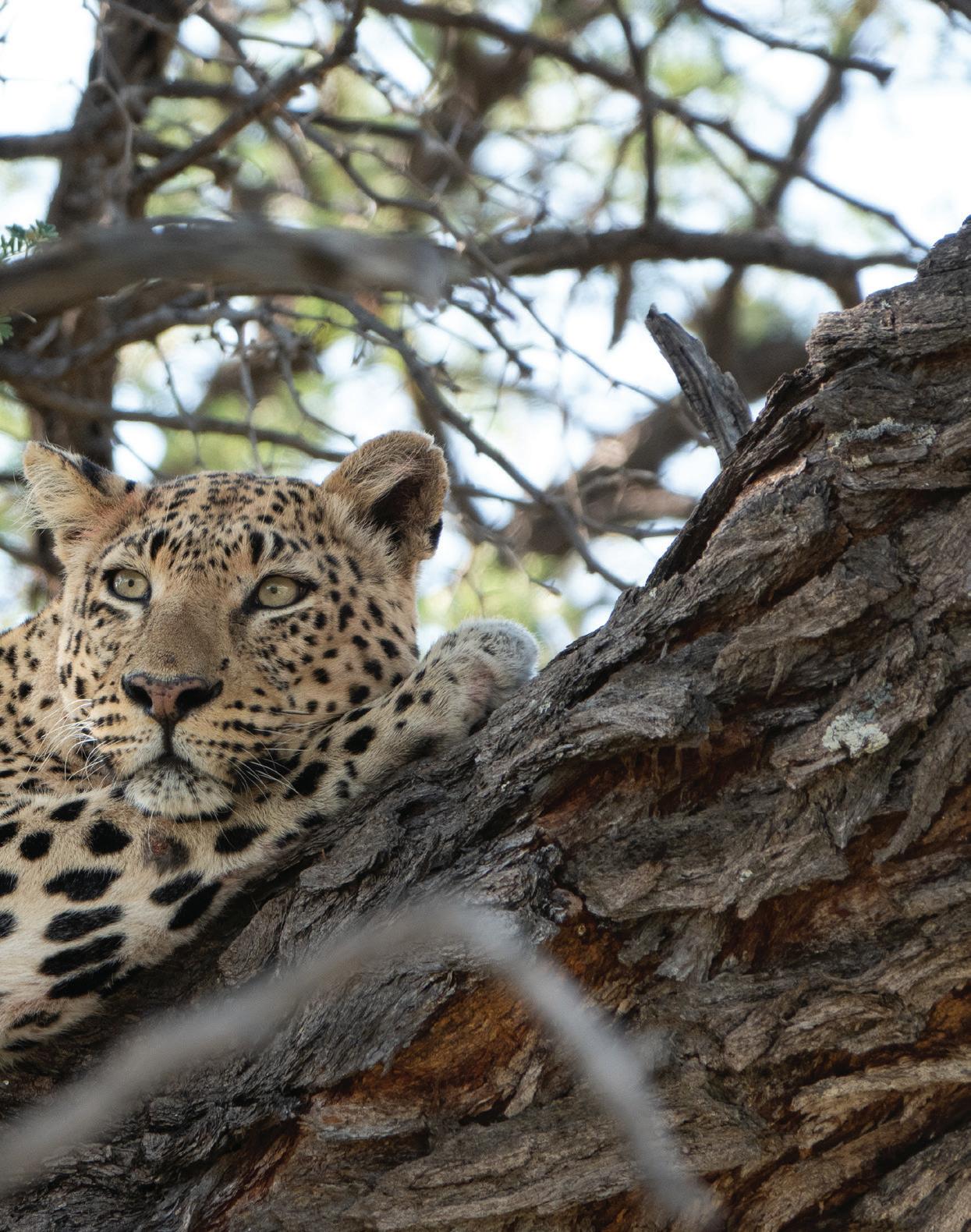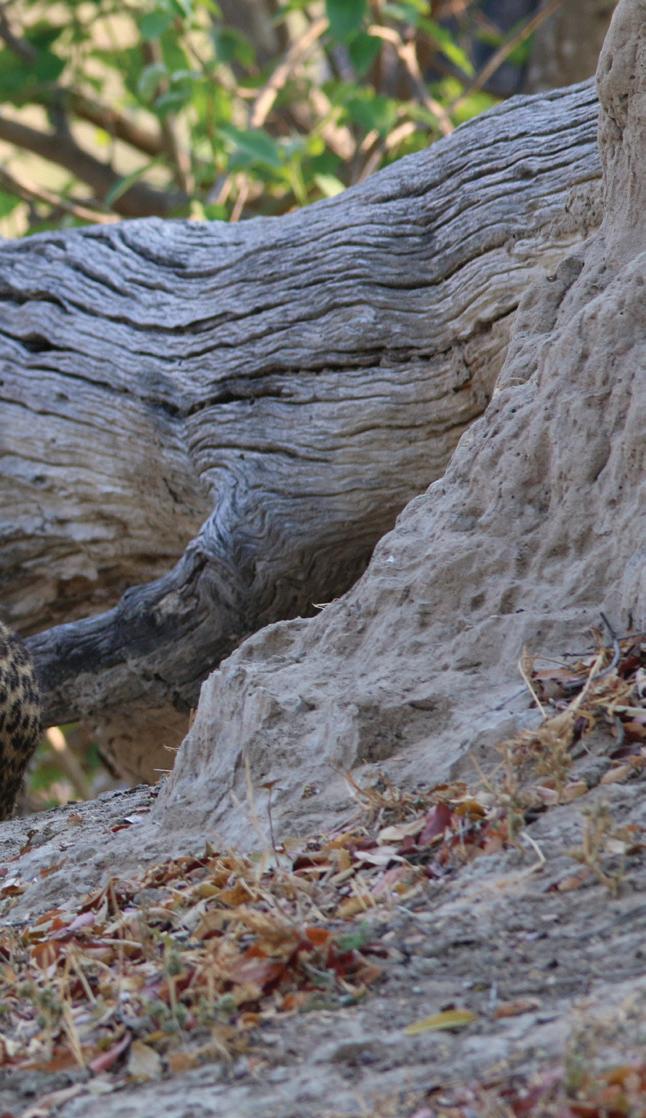
10 minute read
COUNTING CATS – AN UPDATED NATIONAL LEOPARD SURVEY FOR NAMIBIA
COUNTING CATS
– An updated national leopard survey for Namibia
By Gail C. Thomson


Leopards are among the most enchanting big cats in the world. Their beauty, raw power and elusiveness have fascinated humans through the ages. Our fascination with leopards is a double-edged sword for the big cat, however. The value we place on seeing this beautiful big cat draws tourists and provides funding for conservation. On the downside, the leopard’s beauty and power drives the illegal market for their skins and other body parts, which contributes to their decline in some parts of Africa.
Being elusive also has upsides: leopards can live near and even in towns and cities without people realising it. The downside: it is difficult to determine how many there really are. This lack of information hinders effective conservation plans for the species. Besides counting them, we need to know if their numbers are increasing or decreasing, which parts of the country are most important for the species, and what are the worst threats to their survival.
Without this information it is quite easy to believe there are so many leopards that we need not worry about them – until it is too late. While average farm sizes in Namibia range between 10-60 km 2 depending on the region, male leopard territories cover 18-451 km 2 (females occupy smaller areas of 9-224 km 2 within male territories). This means that while farmers may think that they have “many” leopards on their individual properties, it is likely that they share these leopards with several neighbouring farms. When a leopard is killed on one farm its absence is likely to affect the leopard population in a much larger area, as leopards from neighbouring territories will probably move into the vacated territory. Studies covering several farms in one continuous landscape are therefore critical for obtaining detailed information about the health and growth of these local leopard populations over time. They don’t tell us how many leopards there are throughout Namibia, however. If we had endless human and financial resources we could conduct detailed studies that cover the whole country, but this is simply not possible. Recognising these limitations, scientists have developed increasingly accurate ways to estimate large carnivore populations using information collected from a variety of different sources including, but not limited to, detailed studies.
The 2019 National Leopard Project by Dr Louisa Richmond-Coggan (initiated by the Namibia Professional Hunting Association) relied on detailed scientific studies, sightings reported by people throughout the country, and information from farmers, hunters, conservancies and the government. Data from all of these sources were then combined using statistical modelling techniques to provide a population estimate for leopards in Namibia. The final result is a “best guess” of 11,733 leopards.
Due to the size of Namibia and the relatively small area covered by detailed studies, this estimate has a relatively large average error margin of around 5,494. One of the significant improvements of this study over previous ones is that predicted estimates were calculated for blocks of 2x2 km covering the whole country. Predictions for particular locations can be tested in future with detailed studies that will improve the accuracy of the next national leopard population estimate. The National Leopard Project provided a lot more information than just a number of leopards, however, and this is where the results get interesting.
2011 2019


EIS
The map on the left was produced by Dr Andrew Stein’s 2011 national leopard census; at the time the data showed no records of the species throughout most of south-eastern Namibia. The map on the right was produced based on records entered in the Environmental Information System using sightings by “citizen scientists” and the results of the 2019 Leopard Project survey among farmers, showing that leopards occur throughout the southeast.
The 2019 project included results of camera trap studies covering several farms each in two locations – the Auas Mountains near Windhoek and farms near Omaruru. These locations were chosen specifically because Dr Andrew Stein used the same sites during the 2011 National Leopard Project. Farms near the Namib-Naukluft National Park were also part of a camera trap study in 2009-2011 that was repeated in 2013. These detailed studies could therefore give us a glimpse of population trends over time.
2019
The results revealed that leopard numbers had increased by 16% near Omaruru and by 40% near Windhoek, while they declined by 38% near the Namib-Naukluft. This last area, however, naturally supports lower densities of wildlife and game than the other two sites due to low and erratic rainfall. Leopard populations probably fluctuate more in these dry areas as their prey populations respond to each rainy season.
Besides trends, these multi-farm studies show which parts of the landscape support more leopards than others. The findings confirmed that they very much prefer mountainous terrain or dry riverbeds to open, flat areas. When this knowledge is applied to other parts of the country, one can predict where leopards are more likely to occur just by looking at topographical maps and including factors like rainfall and land use that have known effects on leopards.
The model used in the Leopard Project thus relies on information from the smaller-scale studies to predict where leopards are likely to occur throughout Namibia. But three small-scale studies are not enough to create an accurate model for the whole country – a lot more data is needed for that. Fortunately, Dr Richmond-Coggan was not alone.
Dr Louisa Richmond-Coggan

This map shows the results of Dr Richmond-Coggan’s 2019 leopard project that predicts leopard densities for different parts of the country. It provides more accurate density estimates at a finer resolution than the map produced in 2011. It also takes into account the EIS data from 2019, thus expanding the known leopard distribution.

Several carnivore researchers who used camera traps and other methods to study leopards and other large carnivores in different parts of Namibia supplied their data to the national project. Some farmers and hunting operators also use camera traps to monitor game on freehold properties and many of them will remember when they last saw leopards or their tracks. To tap into this information source, the project included a questionnaire that was completed by 392 freehold farmers from all over the country. In communal conservancies, game guards record all carnivore sightings and livestock losses in their Event Books, which provided valuable data on which conservancies reported the most leopard problems. Finally, leopard sightings by tourists or other interested “citizen scientists” are entered into the Environmental Information Service of Namibia (EIS) via the Atlasing in Namibia App, complete with photographs and GPS coordinates.
The Ministry of Environment, Forestry and Tourism (MEFT) also provided a wealth of information to the Leopard Project. Their records show where leopards have been hunted or shot due to conflict with farmers. These permits include the location and various details about the leopard, all of which are entered into the MEFT database.
The data from all of these sources are then fed into the model based on more detailed studies to show us where leopards occur in higher or lower densities across the country. This 2019 study built on the 2011 study that used similar methods to estimate leopard numbers. Comparing the two studies reveals that leopards occur over larger parts of Namibia than previously thought. Most of south-eastern Namibia was considered devoid of leopards in 2011, yet they were found there in 2019.
Although the known distribution of leopards across Namibia expanded to the southeast in 2019, new data from north-eastern Namibia revealed a lower leopard density in 2019 than was predicted by the 2011 study. As a result of these changes in density estimates and increased accuracy of the model, the model’s “best guess” of 11,733 leopards in 2019 is lower than the 2011 “best
guess” of 14,154 leopards. These changes are more likely due to increased accuracy and better density estimates than actual population declines. In her final report Dr Richmond-Coggan recommended more detailed studies in areas where we currently have predictions for leopard numbers, but not enough good data to confirm or refute those predictions. The sites of past detailed studies should also remain a priority for regular repeat studies to keep track of changes over time. Each national leopard survey should thus build on the previous ones to create an increasingly accurate understanding of the Namibian leopard population. Leopard distribution and estimated numbers are just one part of the broader conservation picture, however. We also need to know what threatens their survival and whether or not our management systems are harming or helping them. The farmer survey for the Leopard Project revealed that human-wildlife conflict, particularly on freehold farms, was the most severe threat to leopards in Namibia. This is particularly important because freehold properties sustain more leopards than the national parks and communal areas.
It is difficult to keep track of how many leopards farmers kill to protect their livestock or game, because only 45% of them (according to the survey of 392 farmers) apply for a permit and/or report these incidents to MEFT. Livestock loss to leopards is related to availability of their natural prey (e.g. small antelope): farmers in regions with low leopard prey densities were more likely to lose livestock to leopards and less likely to tolerate them than farmers in areas with more leopard prey. The results also showed that game farmers or mixed livestock-game farmers were more tolerant of leopards than farmers with livestock only.
Private game reserves that rely on photographic tourism (e.g. Erindi) are key areas for leopard conservation, supporting higher densities than our national parks. Game farms that rely on hunting or a mix of photographic and hunting tourism also support high leopard numbers. Their antelope species are the leopard’s natural prey, however, making it almost impossible for them to protect their livelihoods from these predators. Game farmers are nonetheless most likely to benefit from occasional leopard trophy hunts, which are far more valuable than most antelope hunts. If the benefit of tolerating leopards outweighs the cost of the losses they cause, then game and livestock farmers will continue to host important parts of the Namibian leopard population. Freehold and communal farmers are custodians of the national leopard population in Namibia. Promoting coexistence between farmers and leopards is therefore vitally important for leopard conservation.

Trophy hunting must nonetheless be well managed to prevent negative impacts on the leopard population. Amendments to the laws on leopard hunting, made after the last national survey, have increased the weight and age of hunted leopards. The most significant reforms were a ban on hunting with dogs in 2010, introducing a new permit system in 2011 and prohibiting female leopard hunts. The hunting success rate has subsequently declined to 27% and only larger male
leopards have been hunted since the reforms. Although Namibia has an annual hunting quota of 250 leopards, the number has not been reached in any year since 2011. The final report therefore recommended that the national quota remain the same, but suggested that regions with more leopards be allocated a larger proportion of the quota than those with fewer leopards. The level of human-leopard conflict reported by farmers in an area should also be taken into account, to ensure that farmers experiencing more conflict have a greater chance of benefiting from leopard hunting.
Despite the advent of camera traps and sophisticated statistical models these elusive cats are still extremely difficult to count. The latest survey reveals that Namibia’s leopard population remains reasonably healthy, thanks in large part to farmers who tolerate their presence and maintain their natural prey species. MEFT and conservation scientists must therefore work closely with farmers to further promote coexistence with this beautiful big cat.
Reference: Richmond-Coggan, L. (2019). The Namibian leopard: National census and sustainable hunting practices. Namibia Professional Hunting Association and the Ministry of Environment, Forestry and Tourism.










